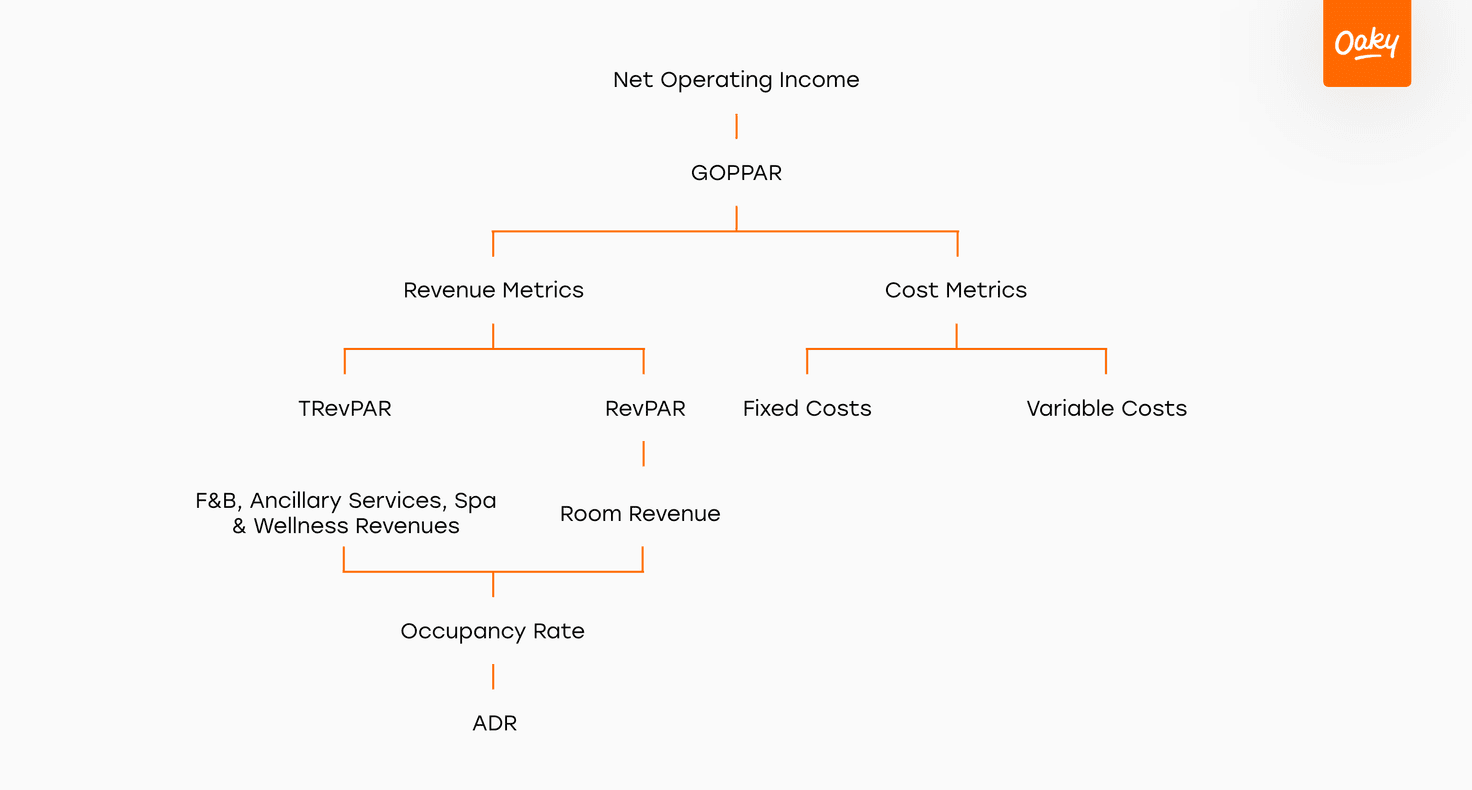The most important KPIs for hotels in 2022
Oaky
•

Over the course of the pandemic, I was in constant contact with revenue and cluster revenue managers from leading hotel brands and independent hotels, helping them to find solutions to decreased demand. In doing so I was able to build an overview of the impact Covid has had and will continue to have over the coming months on their business.

Amongst other topics, my discussions with these hoteliers covered shifting consumer trends, activities to drive demand and ways to reduce non-value-adding expenses. In all of these conversations, I sensed subtle underlying shifts in attitude. Revenue Managers appeared to be unconsciously changing the way they viewed their hotels’ KPIs.
Driving RevPAR as a North Star metric came up only a handful of times, while driving Net Operating Income (NOI), Gross Operating Profit Per Available Room (GOPPAR) and Total Revenue Per Available Room (TRevPAR) came up more frequently than I was used to. It’s as if this constantly changing landscape has empowered Revenue Managers to look beyond a single metric and take a more holistic view of their business, which is now more than ever, a smart move.
Having said that, it's not as easy as simply replacing your North Star metric with another one. You have to identify which key metric you are trying to affect, how different KPIs are interconnected and how you can tweak each individual KPI to help you reach your end goal.
Net Operating Income
Net Operating Income is a hotel’s revenue generated minus their operating expenses, or the money a hotel has earned after all operating expenses. This is a crucial KPI for hotel owners and investors when they evaluate a property. Besides this, hotels rely on this buffer/profit margin to help them get through tough times. With revenue streams dwindling, this buffer is currently acting as a saviour for many hotels, with those that have more money in the bank no doubt more comfortable in the current situation. Hotels that don't have this luxury, will have to work doubly hard to boost this KPI in the coming months to ensure their own survival. They'll need to focus on maximising profits from the little pick-up they are seeing now. Whenever we see an upturn in demand, this focus on driving NOI will pay off.
Net Operating Income as a KPI is hard to directly impact as it’s determined by all of the other KPIs put together and their interconnectedness. Making a big impact on this KPI will call for all hotel departments to work closely together to overcome the crisis. Revenue Managers should drive this KPI in collaboration with other department heads to ensure their hotels profitability and survival. Revenue Managers can tweak other KPI levers to boost TRevPAR and reduce cost metrics, without impacting the quality of service or guest experience. Yes, there will be fixed costs you can’t impact in the shorter term, but you can certainly optimise variable costs in the short term.
Revenue Managers should, however, be cautious about using other levers such as ADR to impact revenue metrics, as this will have an upstream impact on other KPI levers like occupancy rates. The best way forward is to start by determining a minimum profit goal for the hotel. This will help you with setting goals for other interconnected KPIs e.g. GOPPAR, TRevPAR, RevPAR, ADR, occupancy rate and sentiment scores on TripAdvisor/other review sites.
GOPPAR
GOPPAR stands for gross operating profit per available room. If hoteliers want to use a single metric to guide their efforts during this period, it has to be profit-oriented. GOPPAR can help hoteliers to see how they are performing on a high level. GOPPAR shows how revenues and expenses are being distributed per team and cascading to the bottomline. GOPPAR can also help you shine light on the inefficiencies standing in the way of achieving the profit goals of a hotel.
GOPPAR can increase if we focus on using all the options available to us. For instance, one can smartly tweak ADR rates to leverage occupancy rates and drive the highest TRevPAR possible with given occupancy at minimal expenses. Dropping rates to boost occupancy in the short-term will generate more revenue, but in the mid-term you may lose out on profits if you are not driving that extra TRevPAR. It’s important to keep in mind that you perhaps have a fixed minimum cost to service each room/guest. Here, for example, you can incentivise guests to reduce expenses on your behalf. You might offer them a low cost freebie in order to help you reduce operating expenses - i.e. Oaky’s Save the Planet Deal, which opts guests out of unnecessary laundry. Our customers who offer this and similar services reduce their costs by an average of €15/request.
TRevPAR
The TRevPAR KPI concerns total revenue per available room. To make a difficult situation more complicated for hoteliers and revenue managers, ‘post-lockdown’ travellers’ behaviour and expectations have changed. They want to make the most out of what they now recognise to be their limited freedom and they're craving creative experiential deals and services. As a result of this, it looks like Revenue Managers now have to don a creative hat on top of thinking about maximising profits!
RevPAR has forever been that North Star metric that hotels have benchmarked themselves against and organised their activities around. However, RevPAR is only a small revenue metric in the larger picture of maximising revenues and profits. We as an industry need to regroup and revisit how we align our activities. Why not label all teams that can generate revenue as revenue drivers and give them an opportunity to proactively contribute to the revenue potential of the hotel?
Enter TRevPAR. TRevPAR is a comprehensive KPI because it looks at, and invites revenue, from all departments, effectively generating a higher total revenue for the hotel. A smart Revenue Manager who recognises the true revenue potential of the hotel can ask each department how they can contribute to driving TRevPAR. Ideas that all departments can provide value to include things like an attractive booking package or a smart (in-person/digital) upselling strategy. A Revenue Manager who does not collaborate with other teams and only worries about advancing RevPAR is missing out on the inherent benefits of collaboration.
When thinking about driving TRevPAR, first think what your NOI goals are. Then turn your focus to driving more revenue from F&B, parking, ancillary services, spa services, any activity that guests can spend on, beyond room upgrades! For instance, if a guest has booked your most expensive Suite Room, how can you entice this high-flyer to spend even more? For a mid-level spender, can you bundle these services together with a room upgrade, killing two KPIs with one stone?
Occupancy rate
A hotel’s occupancy rate refers to the percentage of available rooms sold for a certain period of time. Having your end profit goals in mind will help revenue managers to calculate their minimum occupancy rates in order to either break even or turn a small profit. Occupancy rates, like all other KPIs, have to be viewed within the context of other KPIs.
For instance, will high occupancy rates have an impact on TRevPAR and other cost metrics? You could be pleased at achieving a 100% occupancy after dropping your ADRs to generate revenue in the short-term, but in doing so have only attracted guests with low TRevPAR potential. At the same time, there will be spend required to service these guests, which may drive up cost metrics and possibly lower your NOI. When thinking about occupancy rates, don’t forget to check in on whether you’re focusing on the quality or quantity of guests. Do you want to attract budget-conscious travellers or travellers who can spend?
ADR
The ADR or Average Daily Rate is calculated by dividing the number of rooms sold by the the revenue earned from said rooms. This KPI is usually used to compare hotels’ historic performance and benchmark themselves against similar or competing hotels in the same market. ADR is also a lever normally used to impact occupancy rates as explained above.
The goal here for a Revenue Manager should be to increase the ADR incrementally, by leveraging/improving their hotel’s reputation/branding, infrastructure and packages. The higher the ADR a hotel is able to command, the higher the quality of guest they attract. An important determinant of this is your sentiment score on TripAdvisor and other similar review sites, which we’ll delve into shortly. Are guests raving about the amazing service/experience and ancillary services offered to them (TRevPAR)?
Guests who are comfortable with a higher ADR can also have a higher spending capacity during pre-arrival or in-stay which could also have a positive effect on your TRevPAR. On the flipside, you could potentially reduce your ADR marginally, but only in the knowledge that you have a solid pre-arrival/during-stay upselling strategy to drive your TRevPAR.
Sentiment score on review sites
The importance of this small, yet powerful KPI cannot be emphasised enough! A sentiment score aggregating online reviews is comparable to an NPS score (net promoter score) i.e. how likely you are to recommend this hotel to your friends. It is standard practice now, especially among Millennials and even more in Gen Z, to read reviews before making any purchase decisions. Your review pages are like free marketing/sales pages for your hotel that can bring or take away business from hotels.
So focus on how you can shine and showcase your product here. Think about all the amazing ancillary services/experiences you can offer your guests that will lead them to leaving a glowing review that will bring in even more guests to the hotel. It is, in essence, like a never-ending sales loop. To stay on top of guest sentiment towards your hotel, you can either use a social media monitoring tool or simply closely monitor your average ratings and guest comments on Tripadvisor and other sites that you deem important to your hotel’s performance.
When we look at isolated metrics and KPIs, we are only looking at one piece of a puzzle. More often than not, it's hard to improve bottom line KPIs without first making an impact on the other KPIs that drive them. The best way is to look at all the metrics and aim to make incremental improvements to top line KPIs to make a significant improvement in bottom line KPIs. The concept of leading and lagging indicators can help.

These indicators go hand-in-hand – tweaking one will result positively or negatively on the other. The best way to take advantage of this would be to start with the end log in mind and then work backwards to achieve the required results.
To summarise, it is highly recommended to look at KPIs together or in context with others rather than in isolation when looking at achieving a wider business goal for your hotel, with the goal in the current scenario being to survive with some cash in the bank!
The key things to remember:
- You are now in fierce competition for a very small group of travellers.
- These post-lockdown travellers are looking to spend, and are craving unforgettable experiences. Think about how, with the limited resources you have, you can make their stay memorable! These things can even be small gestures such as leaving a handwritten thank you note on the day of check-out.
- When these guests have gained a story worth telling from an experience at your hotel, they will happily talk about it to their friends and leave reviews on platforms. This is what will drive business for your hotel organically.
- Don’t underestimate the power of collaborating with all departments to think about optimising hotel expenses and creating upsell opportunities throughout the entire guest journey!
- Think of ways you attract travellers by making small but integral changes across the board, i.e. by tweaking your ADR and packages, introducing a manual or digital upsell strategy to drive your TRevPAR, and having your costs in check to improve your GOPPAR / NOI.
Thanks for reading! As ever, if you have any questions we're always here to help!


